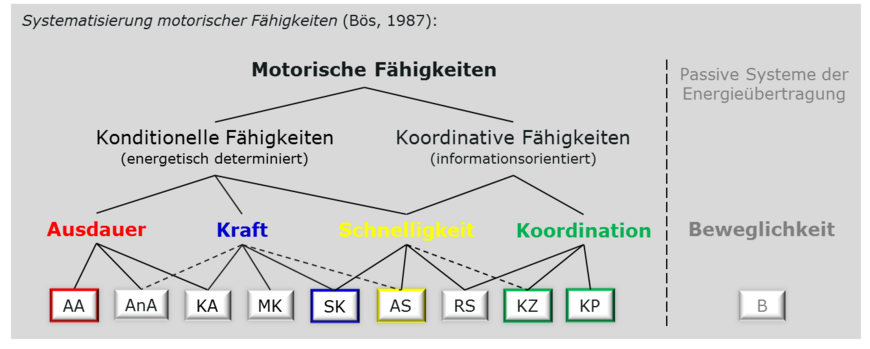Test Battery
Since the primary purpose of EMOTIKON is to assess and evaluate physical fitness of third graders aged 8.0 to 9.0 years in a state-wide effort, our aim was to develop a test battery that is suitable for the physical education setting. Physical education is characterized by specific conditions such as limited space, equipment, and time. Therefore, all tests should be economical, practicable, and should require only minimal school specific equipment (e.g., stopwatch, measuring tape, medicine balls, pylons). Furthermore, the tests should cover different components of physical fitness in order to provide a holistic evaluation of children’s physical fitness status. Due to these circumstances together with long-lasting experiences from the EMOTIKON study (2006-2009), six previously published physical fitness tests (mostly from the German Motor Test) were included in a physical fitness test battery (cf. fig. 3).
Until 2015, the specific test battery comprised six tests for the assessment of cardiorespiratory endurance (i.e., 6 min run test), change-of-direction speed (i.e., star run test), speed (i.e., 20-m linear sprint test), flexibility (i.e., stand and reach test), proxies of lower (i.e., standing long jump test), and upper limbs muscle power (i.e., ball push test). In 2016, the one-legged balance test was included in the test battery because of strong statistical correlations between balance, cognitive function and injury risk in children. At the same time, the stand and reach test was excluded from the test battery. However, the stand and reach test can still be carried out voluntarily.
More detailed information in regards of the different physical fitness tests are illustrated in the test manual and in short video clips.
| TEST-MANUAL | 6 min run test | Ball push test | Standing long jump test |
| 20-m linerar sprint test | Star run test | Stand and reach test (2010-2015) | One-legged balance test (since 2016) |
| Note for video download: Once the video has opened → right-click and select "Save video as...". | |||
Anthropometric Survey
Since school year 2021/2022, anthropometric data is being collected in addition to the performance in six physical fitness tests. In a written survey, parents can voluntarily provide children’s body height and weight, along with information about sports club membership or participation in an extracurricular sports activity. Anthropometric data are used to analyze the association between body constitution and physical fitness.
Longitudinal Study
In the district of Potsdam-Mittelmark, a longitudinal study has been conducted starting in 2020 until 2023. In addition to all third-graders, the study assessed all children from the fourth, fifth, and sixth grades, tracking the individual fitness development of children over four years. Various factors affecting the development of physical fitness were examined, including age, gender, and age at school enrollment. A heartfelt thank you to the physical education teachers from Potsdam-Mittelmark, without whom this longitudinal study would not have been possible!

